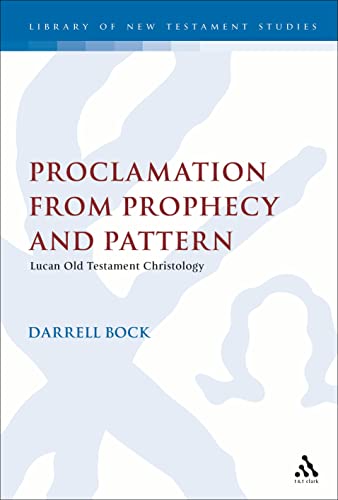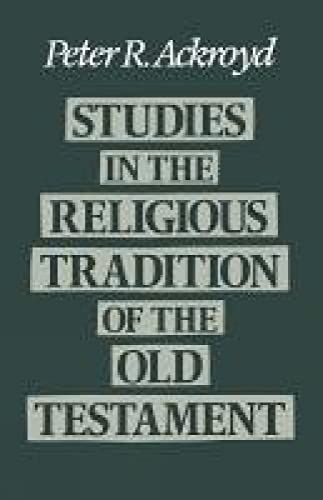Proclamation From Prophecy and Pattern: Lucan Old Testament Christology
Written by Darrell L. Bock Reviewed By Max TurnerThis is a revision of an Aberdeen PhD first submitted in 1982. As befits such study, Bock begins with a chapter which surveys what has been said in the field, focusing particular questions which he wishes to address. These concern the type and source of the christologically-focused text citations or allusions, their tradition-history, their hermeneutics (the relation of Lucan contextual meaning of the citation to the OT meaning and to the event to which it is applied), and the redactional purpose of the use of the OT citations or allusions, particularly their significance in the thematic development or framework of Luke-Acts as a whole (and hence Bock’s analysis follows the order of Luke-Acts, with chapters on the OT christology of Lk. 1–2; 3–24; Acts 2–5 and 7–13, rather than analysing by literary source or by type of OT usage). The very wide scope of Bock’s study makes for a thesis that is not easy on the reader—it is not only very terse, but also a wood in which it is all too easy to become lost for the thick growth of trees.
Perhaps it is the sheer breadth of scope of the enterprise which is chiefly responsible for some of the weaknesses of the work. These include (i) some strange omissions (e.g. of reaction to Jervell’s important theses that ‘in your [Abraham’s] seed’ at Acts 3:25 refers to the Jewish Christian church, not to Christ; indeed Jervell makes no appearance either in bibliography or indices!); (ii) places where opposing arguments seemed to be less than felicitously represented and patiently heard (who would have guessed, for example, the strength of the case that Acts 2:33 depends on Ps. 68:18, and Jewish traditions of interpreting it, from Bock’s presentation of Lindars and Dupont, and these virtually alone (181f.)?); (iii) occasional places where previous work is entirely or seriously misrepresented (see Bock’s handling of the reviewer’s own positions at almost every point!); (iv) some very strained argument (e.g. that used to assert that the Father-Son relation is not a crucial or emphasized Lucan christological motif, and to justify the claim that the inclusion of Is. 58:6 in Lk. 4:18–19 turns the focus of the whole from an Isaianic Servant Christology to a regal messianic one); and (v) what appears to be a slightly unnuanced Jewish messianology (e.g. in the assumption that the Mosaic Prophet was neither messianic nor royal in Judaism, and that a merely real Messiah (except in 1 Enoch) was sufficiently widely expected to make it worth Luke showing Jesus was more than that (contrast Neusner et al, Judaisms and their Messiahs!). But such things are possibly inevitable, albeit regrettable, in a thesis that attempts to cover so much, and in such detail.
Positively, I think Bock has achieved some important results. First; it is commonplace to maintain that the theology of the speeches in Acts is based on the lxx and not the Semitic OT tradition, and to deduce that the speeches in Acts 2–13 cannot therefore be authentic. But Bock has argued that while it is the lxx that is usually (not exclusively) cited, nevertheless not once does the conceptual framework of the argument depend on use of the lxx as opposed to the Masoretic text (or other Semitic OT tradition). Some will think Bock has gone too far, but his thesis at least redresses the balance. Second, he elucidates a more controlled and subtle interface between OT passages and Luke’s messianic interpretation of them than hitherto offered (e.g. he builds a much more plausible bridge of meaning than usual between Pss. 16 and 110 in the OT and their use by Peter in Acts 2). Third, time and again, Bock manages to demonstrate a clear prophecy-fulfilment motif: whether by showing the OT text had a prophetic overtone, or that a prophetic dimension to the passage was already accepted in Jewish interpretation, or that Luke’s text clearly indicates a fulfilment dimension (or in a combination of these). He shows that Luke does not use his OT citations as an apologetic device (‘proof from prophecy’)—contra Schubert: cf. the absence of Matthew’s ‘he did this to fulfil the scripture which said …’ and contra Rese who attempts to eliminate the prophecy-fulfilment aspect from so many citations, reducing them thereby to static OT illustrations of the NT events.
Fourth, he establishes that a major purpose of this use of OT passages is to proclaim and elucidate Jesus in terms of the fulfilment of God’s promises made to Israel in the pattern of her redemptive history and in the prophecies given to her (hence the title). Fifth, he at least in part successfully argues that there is a christological development through the presentation of the OT citations in Luke-Acts. Jesus is at first identified as Messiah, then gradually shown to be more than a ‘mere regal Messiah’ (I would prefer to say the type of his messiahship is clarified): he is ‘Son of Man’, Servant, and especially Lord—the divine sense of the last only emerging most fully in Acts 2 and 10:36–42, and becoming the justification for mission beyond Israel; Jesus is Lord and judge of all.
Bock’s work will rightly join Holtz and Rese as a standard work on Luke’s use of the OT.
Max Turner
London Bible College






